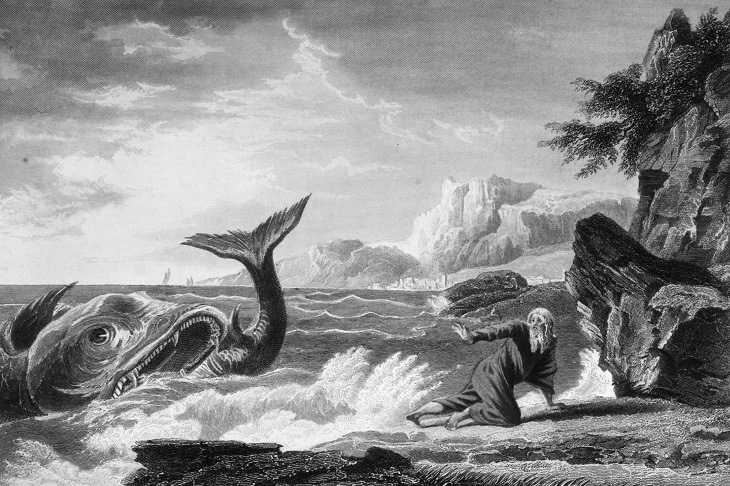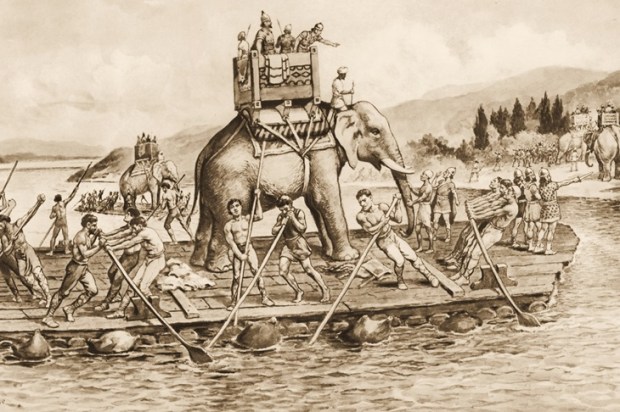Wādī al-Ḥītān, also known as ‘The Valley of the Whales’, is an extraordinary paleontological site sitting 150 km south-west of Cairo, Egypt.
There, the fossilised bones of Archaeoceti (ancient whales), lay exposed in the sands of the Western Desert. The find includes rare specimens of Basilosaurus and Dorudo. 50 million years ago in the beginning of the Eocene, these creatures hunted in the warm, shallow waters of a vanished sea.
In news that will no doubt traumatise those who cling to human-centric climate change, the whales tell a story of a constantly changing Earth that cares little for the survival of its creatures. According to Daily News Egypt:
About 37 years ago at the Fayoum desert, where the 200-square-kilometre Wadi Al-Hitan is located, was covered with water as part of the old Mediterranean Sea ‘Tethys Sea’ which existed about 200 million years ago.
The Tethys Sea existed over Fayoum almost 200m years ago, before shrinking North and becoming the Mediterranean Sea and desertification turning the sea floor into a desert.
These fossil fields, discovered in 1902, are crucial because they helped to answer an enduring mystery in the evolution of whales – finally proving that they switched from being land-based mammals into ocean-going creatures.
Other places contain similar fossils, but nowhere is there such a rich layer of preservation allowing palaeontologists to reconstruct the long-lost ecosystem. Unesco, in an unusual moment of clarity, designated the area as a protected World Heritage site. It sits as an open-air museum with over 400 whale fossils and countless other priceless examples of prehistoric life lying in situ.
These are strange whales. In excess of 20 metres, they had both flippers and hind legs with feet and toes while their bodies were elongated, resembling enormous serpents. Unlike modern whales, they retained the powerful jaws and teeth of land-based predecessors.
The skeletons of modern whales contain vestigial hind leg bones that indicate a ghost-like past on land which serve no purpose in the water. They are being erased by the gradual process of natural selection leading scientists to guess that these creatures had once walked on land.
Finding transitional fossils to prove this is a game of luck, but in the case of whales, luck fell on the side of science. The legs, knees, and feet of the desert whales solidified the main theory but also discounted previously assumed ancestors causing a ruthless re-shuffling of life’s tree. Such is the brutality of physical evidence.
Science, if it wishes to be called such, must always bend to real-world data – even if it hurts our feelings.
This can be difficult for those who fall in love with beautiful theories, something that happens frequently to the scientists who dream them up and the ideological movements that worship them. Plenty of elegant theories have been crushed under the weight of conflicting evidence and this is never more dangerous than when humans associate a theory with personal ‘virtue’.
The miasma theory of infectious diseases, held as the gold standard by experts in the field of medicine, was superseded by modern germ theory. ‘Bad air’ or ‘night air’ was originally thought to be the cause of catastrophic epidemics that plagued the ancient world. Hippocrates popularised the globally-held view that bad odours caused illness. This belief, while ultimately wrong, was not entirely detrimental to the development of civilisation as it led to cities cleaning up rotting waste and the creation of water purification techniques which genuinely lowered the prevalence of disease breeding grounds.
The theory of classical elements – where all matter was composed of air, earth, fire, and water – persisted until 1789 when it was put to rest by Antoine Lavoisier in his work Elements of Chemistry. Mind you, the 90s-era Captain Planet children’s cartoon has a lot to answer for when it comes to children mistaking these features for ‘elements’. As for poor Lavoisier, he was rewarded for his efforts to improve the lives of the French peasants with a trip to the guillotine in 1794. It was said of his loss, ‘It took them only an instant to cut off his head, and one hundred years might not suffice to reproduce its like.’ He was later exonerated of any wrongdoing.
Maternal Impression was extremely popular in which doctors believed the mother of a child could spontaneously create birth defects through her ill-thoughts. It was a nasty way to blame women for the malformed and tragic fates of their children. One of the most severely disabled figures in history, Joseph Merrick (known as ‘The Elephant Man’), said that his mother believed his condition was caused by her accident involving an elephant while she was pregnant.
The luminiferous aether was an extremely popular idea that space was saturated by a mysterious substance that allowed light to travel. Waves require mediums and logically scientists assumed that the same must be true of light. At the time, space was reliably reported to be a vacuum, so in order to fit observations, the aether was given properties that made it invisible and un-measurable – in other words, properties that amounted to it not existing at all. It was a theory created to fit one known fact which frustrated scientists to the point they had to sit down and instead consider ways for light to travel without a medium. The aether did not fall out of favour until Einstein’s work on Special Relativity. This is a corner of science that is still evolving, with the discovery of quantum theory’s vacuum energy muddying the elegant solution. It is not the aether as envisioned by previous scientists, but its existence does raise questions about the nature of energy and while the quirks of vacuum energy are observed, its true nature remains unconfirmed. Who knows, it may be thrown on the scrap heap in due course.
There are thousands upon thousands of scientific missteps made by humans desperately trying to answer questions about the world with limited technology. Modern science remains littered with these relics, such as the nostalgically named ‘standard candles’ of astronomy and the vicious debate between Convention Current Flow coined by Benjamin Franklin versus the real direction of Electron Flow. Franklin was wrong, but the drawing convention held. Many scientists believe that we should stop teaching each generation the error and update the system. But that takes effort, so ‘science’ leaves the error and tells students to visualise the reverse of what’s written.
Why the scientific, engineering, and academic communities refused to change to electron flow is not known. It is likely that the feeling was that electrical theory was always taught using the conventional current flow model and there was no particular need, desire, or reason to change. Change is difficult and tradition dies hard.
If you feel like starting a war among engineers – this is a good place to start after a few glasses of champagne.
In the past, religious organisations tended to be the powerful institutions that held onto scientific theories and modelling long after scientists wished to move on under the weight of conflicting evidence.
This desire to clutch at discarded theories arises from the problem of power. Science is often interchangeable with ‘knowledge’. Those with knowledge of the world are considered to be powerful, particularly in human eras where most people could not read, let alone describe natural processes. Information was akin to magic, often dangerously so. The church and, to a lesser extent, political institutions, used science to validate their power in the eyes of the public. Just as ‘the divine will of God’ anointed Kings, supreme knowledge about the universe appointed the Church in all its various forms around the world.
Power implies stability and was used to prop up dynasties. These institutions were a poor match for the shape-shifting nature of science which exists in a perpetual state of evolution, changing its mind and refining its ideas.
Two particular scientific ideas infuriated the church during the great upheaval of Enlightened Thought: the Earth being demoted to a planet orbiting the sun, and humanity finding its magical biological status downgraded to ‘just another animal’. Neither of these helped promote the idea that we were the centre of God’s creation. While these discoveries conflicted with the teachings of all religions, they clashed with the Christian religion due to its proximity to rapid scientific expansion happening in Europe.
Modern religion has learned to make peace with observed reality, adapting rather than allowing science to dismantle it. We may call this a sensible arrangement to avoid a nasty ideological war between reality and faith.
This topic is brought up not to upset religious readers, but to hang a lantern on a dangerous parallel taking place today that has no such peaceful intentions.
Science is once again beholden to powerful institutions that have built their reputation, financial dominance, and political supremacy on scientific theories. These theories are propped up by notoriously flimsy modelling that continues to fall short of its apocalyptic promises.
The desired establishment of a globalist (and boldly socialist) bureaucracy – held together with international corporations that usurp the sovereignty of democratically elected leaders – is being justified by the threat of global apocalypse.
If that apocalypse is a lie – if its doomsday is a fabrication – then all of the money and expansion of power has been enacted under false pretences.
‘Climate Change’ is shaping up to be the most expensive scientific fraud in human history with its falsity betrayed by the failings of bizarre theocratic ‘preachings’. We should be asking questions like, why is the scientific community using radicalised children to promote its narrative? Does that sound ‘normal’ or sane? Why are its leaders telling children not to go to school but rather to glue themselves to city streets or scream in deranged fits of hysteria?
Children are offered up to appeal to the emotions, rather than logic, of adults – which should have been the first warning sign that something extremely dangerous is taking place.
Challenging this ‘science’ threatens the most powerful people in the world – and their fortunes.
This is why we find their scientific ‘consensus’ regarding climate change propped up by enormous academic grants and corresponding punishments, ensuring that science is ‘guided’ toward confirming climate change bias.
The lack of an apocalypse remains climate change’s biggest problem. Its second biggest problem is 4.5 billion years of geological history. Every time a climate ‘end date’ slips by, it invalidates the cherished beliefs of those who can only be described as zealots, charlatans, and victims of propaganda.
Science says that the world is not ending, and if it is not ending, it’s time to claw our country back from these ideological squatters.
The whales in the desert are all around us. We are tripping over evidence that the world is not ending – that droughts and floods are part of our natural cycle – and that it is normal for nasty weather to rough us up on a semi-regular basis. The tides are not drowning us nor is a global catastrophe gnawing at our city walls.
Emotion, not reason, holds us to the lie of apocalypse – no doubt feeding the laughter of those behind the curtain of power.
Alexandra Marshall is an independent writer. If you would like to support her work, shout her a coffee over at donor-box.
Got something to add? Join the discussion and comment below.
Get 10 issues for just $10
Subscribe to The Spectator Australia today for the next 10 magazine issues, plus full online access, for just $10.


























Comments
Don't miss out
Join the conversation with other Spectator Australia readers. Subscribe to leave a comment.
SUBSCRIBEAlready a subscriber? Log in